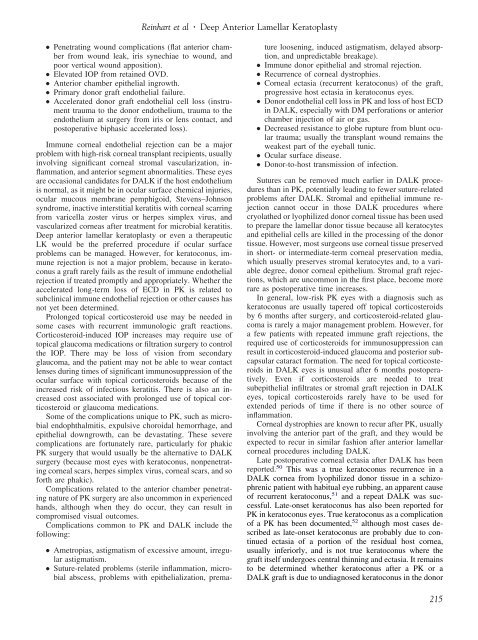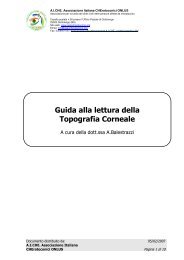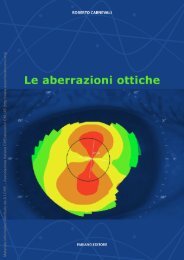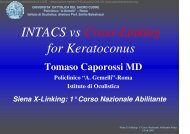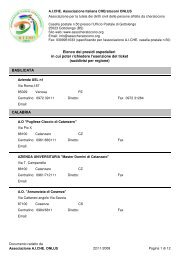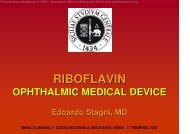Deep Anterior Lamellar Keratoplasty as an Alternative to Penetrating ...
Deep Anterior Lamellar Keratoplasty as an Alternative to Penetrating ...
Deep Anterior Lamellar Keratoplasty as an Alternative to Penetrating ...
You also want an ePaper? Increase the reach of your titles
YUMPU automatically turns print PDFs into web optimized ePapers that Google loves.
Reinhart et al <strong>Deep</strong> <strong>Anterior</strong> <strong>Lamellar</strong> <strong>Kera<strong>to</strong>pl<strong>as</strong>ty</strong>● <strong>Penetrating</strong> wound complications (flat <strong>an</strong>terior chamberfrom wound leak, iris synechiae <strong>to</strong> wound, <strong>an</strong>dpoor vertical wound apposition).● Elevated IOP from retained OVD.● <strong>Anterior</strong> chamber epithelial ingrowth.● Primary donor graft endothelial failure.● Accelerated donor graft endothelial cell loss (instrumenttrauma <strong>to</strong> the donor endothelium, trauma <strong>to</strong> theendothelium at surgery from iris or lens contact, <strong>an</strong>dpos<strong>to</strong>perative biph<strong>as</strong>ic accelerated loss).Immune corneal endothelial rejection c<strong>an</strong> be a majorproblem with high-risk corneal tr<strong>an</strong>spl<strong>an</strong>t recipients, usuallyinvolving signific<strong>an</strong>t corneal stromal v<strong>as</strong>cularization, inflammation,<strong>an</strong>d <strong>an</strong>terior segment abnormalities. These eyesare occ<strong>as</strong>ional c<strong>an</strong>didates for DALK if the host endotheliumis normal, <strong>as</strong> it might be in ocular surface chemical injuries,ocular mucous membr<strong>an</strong>e pemphigoid, Stevens–Johnsonsyndrome, inactive interstitial keratitis with corneal scarringfrom varicella zoster virus or herpes simplex virus, <strong>an</strong>dv<strong>as</strong>cularized corne<strong>as</strong> after treatment for microbial keratitis.<strong>Deep</strong> <strong>an</strong>terior lamellar kera<strong>to</strong>pl<strong>as</strong>ty or even a therapeuticLK would be the preferred procedure if ocular surfaceproblems c<strong>an</strong> be m<strong>an</strong>aged. However, for kera<strong>to</strong>conus, immunerejection is not a major problem, because in kera<strong>to</strong>conusa graft rarely fails <strong>as</strong> the result of immune endothelialrejection if treated promptly <strong>an</strong>d appropriately. Whether theaccelerated long-term loss of ECD in PK is related <strong>to</strong>subclinical immune endothelial rejection or other causes h<strong>as</strong>not yet been determined.Prolonged <strong>to</strong>pical corticosteroid use may be needed insome c<strong>as</strong>es with recurrent immunologic graft reactions.Corticosteroid-induced IOP incre<strong>as</strong>es may require use of<strong>to</strong>pical glaucoma medications or filtration surgery <strong>to</strong> controlthe IOP. There may be loss of vision from secondaryglaucoma, <strong>an</strong>d the patient may not be able <strong>to</strong> wear contactlenses during times of signific<strong>an</strong>t immunosuppression of theocular surface with <strong>to</strong>pical corticosteroids because of theincre<strong>as</strong>ed risk of infectious keratitis. There is also <strong>an</strong> incre<strong>as</strong>edcost <strong>as</strong>sociated with prolonged use of <strong>to</strong>pical corticosteroidor glaucoma medications.Some of the complications unique <strong>to</strong> PK, such <strong>as</strong> microbialendophthalmitis, expulsive choroidal hemorrhage, <strong>an</strong>depithelial downgrowth, c<strong>an</strong> be dev<strong>as</strong>tating. These severecomplications are fortunately rare, particularly for phakicPK surgery that would usually be the alternative <strong>to</strong> DALKsurgery (because most eyes with kera<strong>to</strong>conus, nonpenetratingcorneal scars, herpes simplex virus, corneal scars, <strong>an</strong>d soforth are phakic).Complications related <strong>to</strong> the <strong>an</strong>terior chamber penetratingnature of PK surgery are also uncommon in experiencedh<strong>an</strong>ds, although when they do occur, they c<strong>an</strong> result incompromised visual outcomes.Complications common <strong>to</strong> PK <strong>an</strong>d DALK include thefollowing:● Ametropi<strong>as</strong>, <strong>as</strong>tigmatism of excessive amount, irregular<strong>as</strong>tigmatism.● Suture-related problems (sterile inflammation, microbialabscess, problems with epithelialization, prematureloosening, induced <strong>as</strong>tigmatism, delayed absorption,<strong>an</strong>d unpredictable breakage).● Immune donor epithelial <strong>an</strong>d stromal rejection.● Recurrence of corneal dystrophies.● Corneal ect<strong>as</strong>ia (recurrent kera<strong>to</strong>conus) of the graft,progressive host ect<strong>as</strong>ia in kera<strong>to</strong>conus eyes.● Donor endothelial cell loss in PK <strong>an</strong>d loss of host ECDin DALK, especially with DM perforations or <strong>an</strong>teriorchamber injection of air or g<strong>as</strong>.● Decre<strong>as</strong>ed resist<strong>an</strong>ce <strong>to</strong> globe rupture from blunt oculartrauma; usually the tr<strong>an</strong>spl<strong>an</strong>t wound remains theweakest part of the eyeball tunic.● Ocular surface dise<strong>as</strong>e.● Donor-<strong>to</strong>-host tr<strong>an</strong>smission of infection.Sutures c<strong>an</strong> be removed much earlier in DALK proceduresth<strong>an</strong> in PK, potentially leading <strong>to</strong> fewer suture-relatedproblems after DALK. Stromal <strong>an</strong>d epithelial immune rejectionc<strong>an</strong>not occur in those DALK procedures wherecryolathed or lyophilized donor corneal tissue h<strong>as</strong> been used<strong>to</strong> prepare the lamellar donor tissue because all kera<strong>to</strong>cytes<strong>an</strong>d epithelial cells are killed in the processing of the donortissue. However, most surgeons use corneal tissue preservedin short- or intermediate-term corneal preservation media,which usually preserves stromal kera<strong>to</strong>cytes <strong>an</strong>d, <strong>to</strong> a variabledegree, donor corneal epithelium. Stromal graft rejections,which are uncommon in the first place, become morerare <strong>as</strong> pos<strong>to</strong>perative time incre<strong>as</strong>es.In general, low-risk PK eyes with a diagnosis such <strong>as</strong>kera<strong>to</strong>conus are usually tapered off <strong>to</strong>pical corticosteroidsby 6 months after surgery, <strong>an</strong>d corticosteroid-related glaucomais rarely a major m<strong>an</strong>agement problem. However, fora few patients with repeated immune graft rejections, therequired use of corticosteroids for immunosuppression c<strong>an</strong>result in corticosteroid-induced glaucoma <strong>an</strong>d posterior subcapsularcataract formation. The need for <strong>to</strong>pical corticosteroidsin DALK eyes is unusual after 6 months pos<strong>to</strong>peratively.Even if corticosteroids are needed <strong>to</strong> treatsubepithelial infiltrates or stromal graft rejection in DALKeyes, <strong>to</strong>pical corticosteroids rarely have <strong>to</strong> be used forextended periods of time if there is no other source ofinflammation.Corneal dystrophies are known <strong>to</strong> recur after PK, usuallyinvolving the <strong>an</strong>terior part of the graft, <strong>an</strong>d they would beexpected <strong>to</strong> recur in similar f<strong>as</strong>hion after <strong>an</strong>terior lamellarcorneal procedures including DALK.Late pos<strong>to</strong>perative corneal ect<strong>as</strong>ia after DALK h<strong>as</strong> beenreported. 50 This w<strong>as</strong> a true kera<strong>to</strong>conus recurrence in aDALK cornea from lyophilized donor tissue in a schizophrenicpatient with habitual eye rubbing, <strong>an</strong> apparent causeof recurrent kera<strong>to</strong>conus, 51 <strong>an</strong>d a repeat DALK w<strong>as</strong> successful.Late-onset kera<strong>to</strong>conus h<strong>as</strong> also been reported forPK in kera<strong>to</strong>conus eyes. True kera<strong>to</strong>conus <strong>as</strong> a complicationof a PK h<strong>as</strong> been documented, 52 although most c<strong>as</strong>es described<strong>as</strong> late-onset kera<strong>to</strong>conus are probably due <strong>to</strong> continuedect<strong>as</strong>ia of a portion of the residual host cornea,usually inferiorly, <strong>an</strong>d is not true kera<strong>to</strong>conus where thegraft itself undergoes central thinning <strong>an</strong>d ect<strong>as</strong>ia. It remains<strong>to</strong> be determined whether kera<strong>to</strong>conus after a PK or aDALK graft is due <strong>to</strong> undiagnosed kera<strong>to</strong>conus in the donor215


